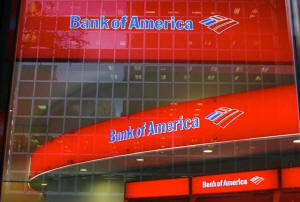|
U.S. banks
want to cut branches, but customers keep coming
 Send a link to a friend
Send a link to a friend
 [August 22, 2016]
By Dan Freed [August 22, 2016]
By Dan Freed
NEW YORK (Reuters) - Despite banks' nudging
toward online tools, many U.S. customers are not ready to give up
regular visits to their nearest branch, complicating the industry's
efforts to slim down.
U.S. banks have trimmed the number of branches by 6 percent since it
peaked in 2009, according to Federal Deposit Insurance Corp data. The
93,283 branches open at the end of last year was the lowest level in a
decade. (http://tmsnrt.rs/2b66WKY)
Yet analysts who have examined the data say banks should have done more
to offset the pressure on revenue from low interest rates and regulatory
demands.
The number of FDIC-insured banks has fallen by more than 25 percent over
that time even as industry assets have grown, indicating room for
greater branch consolidation.
Bank executives argue, however, that branches remain crucial for
acquiring new customers and doing more business with existing ones.
Closures, they say, would hurt revenue more than help reduce costs.
"Our customers still want to visit us," Jonathan Velline, Wells Fargo's
head of ATM and store strategy, told Reuters in an interview. "They're
still coming to our stores and our ATMs at pretty consistent rates."

Bankers across the industry share that view. They say online banking
complements traditional services for U.S. customers, but few have gone
fully digital.
The United States falls somewhere in the middle among developed nations
in terms of how aggressively its banks have been slimming down,
according to the International Monetary Fund's population-adjusted data.
They have cut relatively more branches than banks in Germany, France or
Canada, but not nearly as many as those in Greece, Ireland, Spain or
Italy.
While other factors are at play, one difference is that U.S. customers
still routinely use checks and need branches to process them, said Rick
Spitler, managing director at consulting firm Novantas.
FDIC Chief Economist Richard Brown said he often fields questions why
the industry still has so many branches.
"This thesis…that we have mobile banking and high-tech banking,
therefore the branch offices are dinosaurs and going away appears to be
substantially overstated," he said.
ON EVERY CORNER
The case for reining in sprawling branch networks as a way to cut costs
looks compelling.
The traditional branch costs roughly $2-4 million to set up and
$200,000-400,000 per year to operate, according to Ed O'Brien, an
analyst at Mercator Advisory Group. For big banks with thousands of
branches – many of them clustered in pricey urban centers – it can get
expensive.
For instance, an eight block stretch near Manhattan's Penn Station
houses 14 bank branches - Astoria Bank, Apple Bank, Capital One,
Citibank, HSBC, PNC, TD Bank, Sterling National Bank, Wells Fargo, two
Bank of America branches, and three Chase branches.
Yet bank executives argue that, in a competitive market, they need to be
footsteps away from the best customers.

Executives at JPMorgan Chase & Co <JPM.N>, the country's largest bank,
say each branch earns about $1 million in annual profit, but takes a
decade to reach its full potential.
Chase bankers regularly scrutinize data on branch foot traffic and what
customers do while inside to determine whether a location should remain
open, shut down or shrink.
The bank has shut 265 locations since 2013, roughly 5 percent of its
network, but executives insist that branches remain essential for
JPMorgan's relationships with customers. They are the best way to sell
clients many products and services ranging from mortgages to investment
advice, according to Gordon Smith, JPMorgan's head of consumer and
community banking.
[to top of second column] |

Reflections are seen in the windows of a Bank of America branch in
New York, U.S. on October 8, 2008. REUTERS/Lucas Jackson/File Photo

"Often I will be asked why don't we just accelerate closings. Why
don't we close 400 or 500 branches?" Smith said at the 2016 investor
day. "The answer is that customers won't go there."
John Elmore, vice chairman of community banking and branch delivery
at U.S. Bancorp, says branches are especially important for small
businesses that need to deposit cash frequently, prefer to negotiate
loans in person, or want strategic advice.
"Proximity to their business is a very, very important factor to
their bank selection and their continuing relationship with a bank,"
Elmore told Reuters.
COST QUESTIONS
Banks do keep trying to steer customers to digital tools.
They have reduced the number of tellers and moved them to the back.
Their ATMs can perform more sophisticated tasks and banks have
developed nifty mobile apps for routine banking needs. They are even
experimenting with digital loan underwriting.
Yet customers still expect contact with bank staff and JPMorgan
recently had to hire more tellers after customer complaints.
JPMorgan and Wells Fargo data show most customers visit branches
several times every quarter, though younger clients tend to visit
less often.
It may be too early to tell what happens in the long run when a big
bank shutters many branches.

Bank of America Corp <BAC.N>, which has closed a quarter of its
branches since 2009, could eventually serve as a test case. The bank
says it is done with cuts, but Keefe Bruyette & Woods analyst Fred
Cannon calls for more. He also points to Citizens Financial Group
Inc <CFG.N>, KeyCorp <KEY.N>, Comerica Inc <CMA.N> and Zions Bancorp
<ZION.O> as banks that have not slimmed down enough.
James Abbott, investor relations chief for Zions, said the group had
eliminated roughly 20 percent of its branches since 2009 and
continued to evaluate further cuts. The other banks did not provide
a comment for this story.
Cannon argues their costs are too high, and that they could
eliminate locations without giving up much revenue.
"I think there's going to be a real question about the cost of that
branch infrastructure," he said.
(Reporting by Dan Freed in New York; Editing by Lauren Tara LaCapra
and Tomasz Janowski)
[© 2016 Thomson Reuters. All rights
reserved.]
Copyright 2016 Reuters. All rights reserved. This material may not be published,
broadcast, rewritten or redistributed.
 |